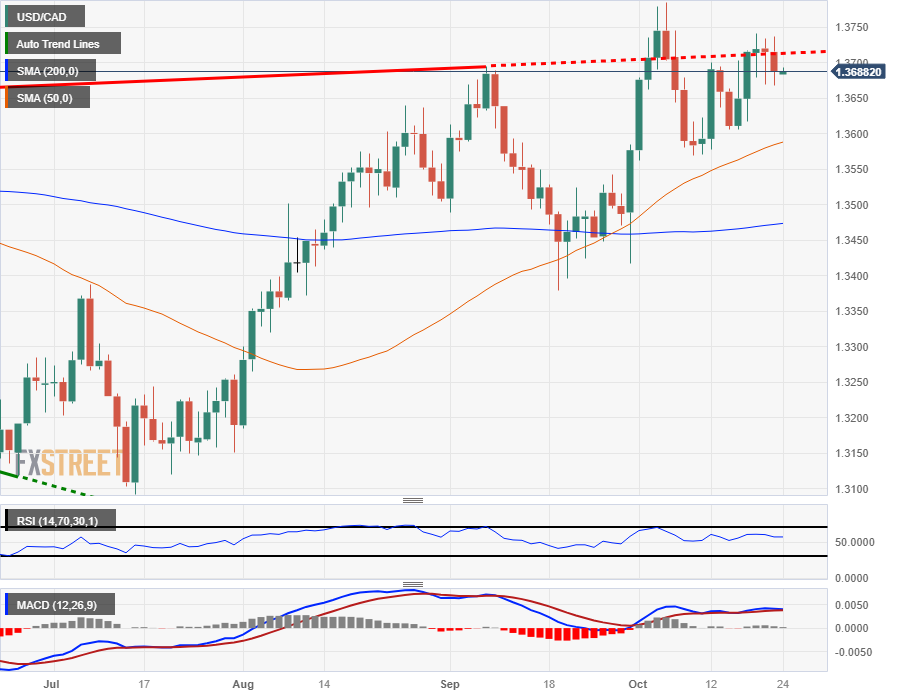Canadian Dollar testing a mild rebound against the US Dollar ahead of BoC rate call
- Canadian Dollar catching some lift as the broad-market US Dollar Index recedes.
- The Bank of Canada lands with its next rate call on Wednesday.
- Market sentiment is improving on Monday, sending the Greenback lower.
The Canadian Dollar (CAD) is finding some lift to kick off the new trading week, bolstered by investors finding their risk appetite in early trading. With the US Purchasing Manager Index (PMI), US Gross Domestic Product (GDP), and US Personal Consumption Expenditure (PCE) Index data all due in the upcoming week, the US Dollar (USD) is going to see plenty of play in the markets in the coming days.
The Bank of Canada (BoC) brings forth its latest rate call on Wednesday with a press conference to follow. The BoC holding their reference rate at 5% is a foregone conclusion, but investors will be watching for any hints of when the Canadian central bank will begin looking at rate cuts.
Daily Digest Market Movers: Canadian Dollar buoyed by US Dollar selling pressure
- The CAD is getting bolstered by broad-market pressure forcing down the USD.
- Crude Oil is also seeing declines for Monday, limiting upside potential in the oil-backed Loonie.
- US PMI figures will be released on Tuesday, overshadowing low-impact Canadian housing prices.
- Canadian New Housing Price Index is expected to show 0.1% gains in September.
- US PMI components are expected to decline slightly; Manufacturing is forecast at 49.5 (last 49.8), and Services is seen at 49.9 (last 50.1).
- The BoC’s next rate call is broadly anticipated to hold at 5%, and investors are hoping for signs that the Canadian central bank will start looking ahead to rate cuts sooner rather than later.
- Potential supply constraints stemming from the Gaza Strip conflict are easing as diplomatic efforts are underway to cool Middle East tensions, pulling back oil bids.
Technical Analysis: Canadian Dollar finds room to stretch in Monday's mild US Dollar sell-off
The Canadian Dollar (CAD) is getting a bump up the charts as the US Dollar wanes across the broader market space, taking the USD/CAD lower on Monday and testing below 1.3700.
After Friday’s bump into its highest bids in almost two weeks, the USD/CAD is fumbling the 1.3700 handle, setting an intraday low of 1.3667 after slipping from the day’s peak at 1.3736.
Monday’s chart action has the USD/CAD set to print an inside candle to kick off the week, and traders will be keeping an eye on any breakouts from immediate chart territory. Near-term technical support sits at the 50-day Simple Moving Average (SMA), which is currently rising into 1.3600, while the ceiling sits at the last swing high into 1.3785.
USD/CAD Daily Chart

Canadian Dollar FAQs
What key factors drive the Canadian Dollar?
The key factors driving the Canadian Dollar (CAD) are the level of interest rates set by the Bank of Canada (BoC), the price of Oil, Canada’s largest export, the health of its economy, inflation and the Trade Balance, which is the difference between the value of Canada’s exports versus its imports. Other factors include market sentiment – whether investors are taking on more risky assets (risk-on) or seeking safe-havens (risk-off) – with risk-on being CAD-positive. As its largest trading partner, the health of the US economy is also a key factor influencing the Canadian Dollar.
How do the decisions of the Bank of Canada impact the Canadian Dollar?
The Bank of Canada (BoC) has a significant influence on the Canadian Dollar by setting the level of interest rates that banks can lend to one another. This influences the level of interest rates for everyone. The main goal of the BoC is to maintain inflation at 1-3% by adjusting interest rates up or down. Relatively higher interest rates tend to be positive for the CAD. The Bank of Canada can also use quantitative easing and tightening to influence credit conditions, with the former CAD-negative and the latter CAD-positive.
How does the price of Oil impact the Canadian Dollar?
The price of Oil is a key factor impacting the value of the Canadian Dollar. Petroleum is Canada’s biggest export, so Oil price tends to have an immediate impact on the CAD value. Generally, if Oil price rises CAD also goes up, as aggregate demand for the currency increases. The opposite is the case if the price of Oil falls. Higher Oil prices also tend to result in a greater likelihood of a positive Trade Balance, which is also supportive of the CAD.
How does inflation data impact the value of the Canadian Dollar?
While inflation had always traditionally been thought of as a negative factor for a currency since it lowers the value of money, the opposite has actually been the case in modern times with the relaxation of cross-border capital controls. Higher inflation tends to lead central banks to put up interest rates which attracts more capital inflows from global investors seeking a lucrative place to keep their money. This increases demand for the local currency, which in Canada’s case is the Canadian Dollar.
How does economic data influence the value of the Canadian Dollar?
Macroeconomic data releases gauge the health of the economy and can have an impact on the Canadian Dollar. Indicators such as GDP, Manufacturing and Services PMIs, employment, and consumer sentiment surveys can all influence the direction of the CAD. A strong economy is good for the Canadian Dollar. Not only does it attract more foreign investment but it may encourage the Bank of Canada to put up interest rates, leading to a stronger currency. If economic data is weak, however, the CAD is likely to fall.